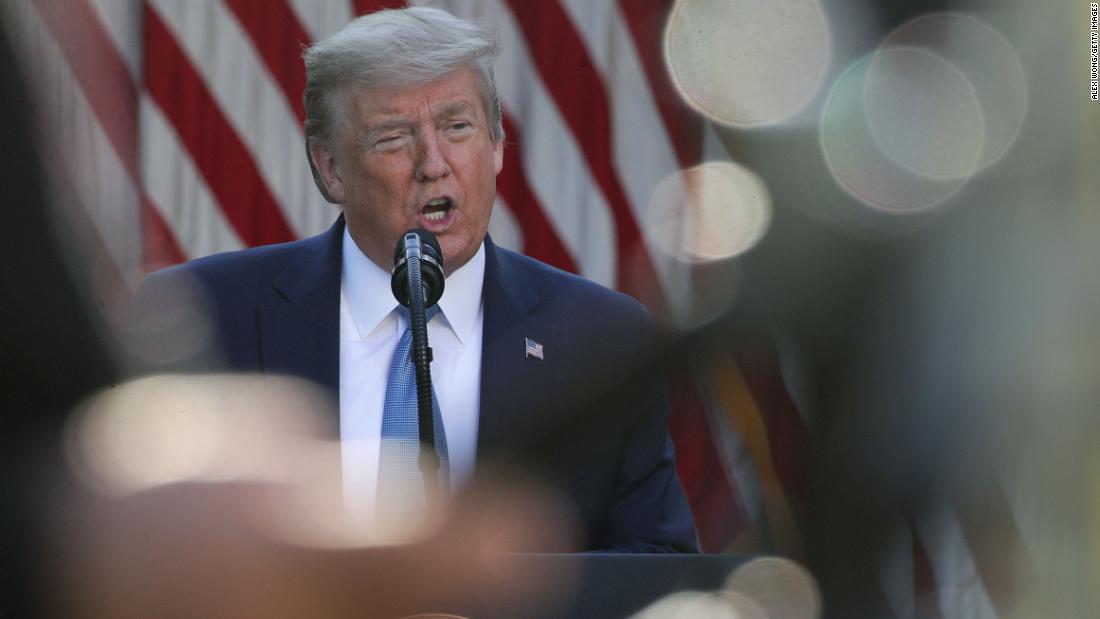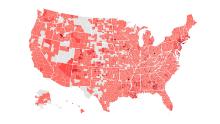[ad_1]
“You are going to call your own shots,” Trump said, according to a person familiar with the conversation. “I’ve gotten to know almost all of you, most of you I’ve known and some very well. You are all very capable people, I think in all cases, very capable people. And you’re going to be calling your shots.”
It was a turnabout from his Monday claim that “the President of the United States calls the shots” in how to ease restrictions that have kept most Americans indoors and forced closures of schools, restaurants, gyms and other businesses. And it was an indication that even as he tries to ease the country out of its virtual shutdown, Trump will place responsibility elsewhere should cases spike again.
“We’re starting our life again,” Trump said, even as it remains to be seen just how quickly any state returns to normal.
But Trump, eager to see a return to normalcy for housebound Americans, wants to provide at least a framework for how places can reopen despite warnings from all corners that testing capacity for coronavirus is still too small.
He said Thursday there were some states that, according to his new plan, could be ready to reopen tomorrow.
“If you look at Montana, Wyoming, North Dakota — that’s a lot different than New York, it’s a lot different than New Jersey,” Trump said.
New guidelines
The benchmarks for the first phase include a sustained decrease in cases over a 14-day period and a return to pre-crisis conditions in hospitals, according to the document.
States should have the “ability to quickly set up safe and efficient screening and testing sites,” the guidelines read, and “quickly and independently supply sufficient Personal Protective Equipment” in hospitals.
The phased approach encourages all individuals to continue good hygiene practices like washing hands and to “strongly consider” using face coverings in public. And the document encourages employers to enact social distancing, temperature checks, testing and sanitation practices in their workplaces.
In the first phase of reopening, the document suggests schools that are currently closed should remain so and employees who are able to telework should keep working from home.
Large venues, including some restaurants, can operate under strict social distancing protocols. Gyms can open as long as they maintain social distancing guidelines, but bars should remain shuttered.
The guidelines still recommend minimizing nonessential travel, and indicate vulnerable populations should remain sheltered-in-place.
Phases two and three gradually decrease the recommended restrictions.
Trump unveiled the guidelines publicly at an early evening news conference.
“We are not opening all at once but one careful step at a time,” Trump said, indicating each state could “tailor” its own reopening plan. “If they need to remain closed, we will allow them to do that.”
In his call with governors, Trump previewed the plan but insisted it would be up to the individual governors to make the decision in their own states when they begin that process.
Trump described the two doctors’ sign-off on May 1 date as a “negotiation.”
“It was a little bit of a negotiation that that’s the way it should be,” Trump said. “I guess, I hope it is that way usually, but we all do want to see things open.”
Birx described the guidelines as “fairly strict” in order to give states time to get testing and surveillance ready.
“That’s to give states really the time to really set up exactly how they’re going to contact trace with the (Centers for Disease Control and Prevention) in the background as supporting,” Birx said on CNN’s Global Town Hall, “Coronavirus: Facts and Fears.”
“I think those two pieces together, we really need to move forward over the next few weeks as the states move through, and really decrease the number of cases.”
‘Absolute authority’ turns into not mandatory
Ahead of their release, officials said the new recommendations would mimic the social distancing guidelines the President announced in March and extended at the start of April: While not mandatory, they carry the weight of the federal government and the presidency.
Many states have already begun drafting plans on returning to normal, including consortia of states on the East and West coasts that have agreed on joint phased reopenings.
Ahead of Trump’s phone call with governors on Thursday, a new collective of Midwestern governors said they were joining together to coordinate on reopening plans. The leaders of Michigan, Ohio, Wisconsin, Minnesota, Illinois, Indiana and Kentucky — both Democrats and Republicans — said they would “work in close coordination to reopen our economies in a way that prioritizes our workers’ health.”
Many of those governors — along with public health experts, lawmakers and business leaders — say that without widespread testing, Americans won’t be able to return to workplaces quickly because it will remain unclear who could still be spreading the virus.
In phone calls with members of the US House and Senate on Thursday, Trump was told by some lawmakers that without increased testing, asymptomatic people may return to workplaces and unknowingly spread further contagion, according to people familiar with the call.
Trump countered by saying his administration had worked to scale up testing and he repeated his dubious claim that the United States had tested more people than any other country.
He also pointed to a new test that people could administer themselves that uses saliva, a person familiar with the conversation said.
It was a similar message to one he received a day earlier during a phone call with some members of his newly formed business advisory council. In that conversation, industry leaders reiterated what public health experts and governors have been telling Trump for weeks: that there would need to be guarantees of ramped-up coronavirus testing before people return to work, according to one person briefed on the discussions.
As they weigh new guidelines on reopening the country, White House officials have pored over data on testing availability and hospital capacity, hoping to more narrowly devise a strategy to improve testing capacity where it still lags.
Trump said Wednesday it was governors’ responsibility to improve testing in their state, shrugging off responsibility for enacting the type of nationwide testing system he was touting only last month.
“We want the states to administer these tests, for the most part,” he said. “We want them to do it, we’re not going to be running a parking lot in Arkansas.”
Different regional rules
Birx, the White House coronavirus response coordinator, said Wednesday there were nine states with fewer than 1,000 cases each who may be the first to lift distancing restrictions. Trump said he believed there could be nearly 30 states in “extremely good shape,” and repeated his assertion that certain places may be able to reopen sooner than May 1.
But even among the nine states with the lowest case counts — Maine, Vermont, West Virginia, Nebraska, North Dakota, Montana, Wyoming, Alaska and Hawaii — not all governors have expressed an eagerness to quickly reopen. Some, such as North Dakota, still appear to be experiencing an increase in cases, meaning their peaks could be weeks away.
Before Trump unveiled the new guidelines, he spent the day on phone calls with foreign leaders and lawmakers. In a teleconference with other G7 leaders, Trump faced resistance to his decision to halt US funding to the World Health Organization.
Trump has claimed the WHO is overly weighted toward China and made grave mistakes early in the coronavirus outbreak, a stance he reiterated on the morning videoconference. But other leaders, including German Chancellor Angela Merkel and Canadian Prime Minister Justin Trudeau, sought to bolster the global health body as essential during the pandemic.
“Much of the conversation centered on the lack of transparency and chronic mismanagement of the pandemic by the WHO,” the White House said in a readout of the conversation. “The leaders called for a thorough review and reform process.”
[ad_2]
Source link




